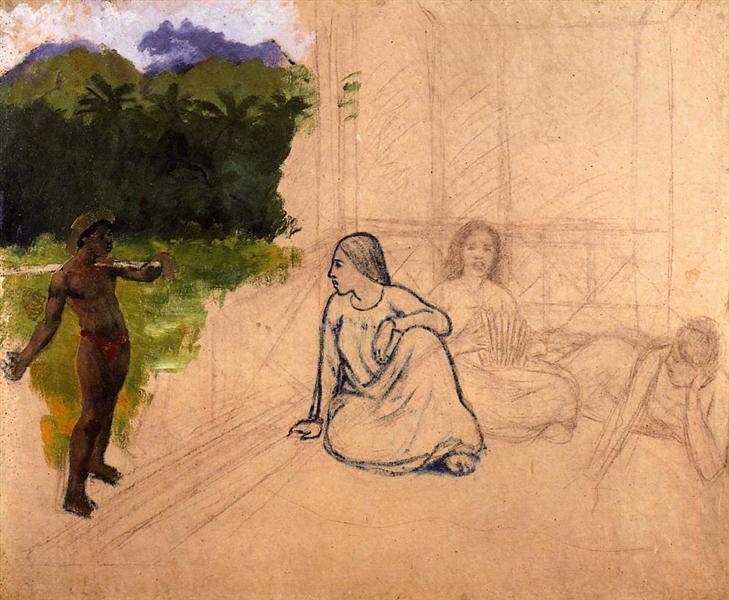Beskrivning
Paul Gauguin's Tahitians at Rest (Unfinished), painted in 1891, is a moving testament to the artist's quest to capture the essence of Tahitian life, a subject that obsessed him during his years on the island. Evaluating this painting allows us to explore not only Gauguin's technique, but also his intention to break away from European traditions and instead embrace a more symbolic and spiritual interpretation of the subject.
The composition of the work is marked by a horizontal arrangement, where the space is divided into three parts. Two main figures, typically Tahitian, rest in the foreground of the painting: one woman is reclining while another, at a more upright angle, seems to observe the landscape around her. This arrangement suggests a tranquility and a connection with the environment, reflecting the idyll of quiet life on the island. The figures are rendered schematically, a technique that Gauguin perfected, less concerned with realism and more focused on conveying a sense of life through shapes and colours.
The use of color in “Tahitians at Rest” is another facet that stands out in the work. Although the painting is listed as “unfinished,” the artist has used a vibrant palette that highlights warm tones, from the yellows and oranges of the characters’ skin to the greens and blues of the natural environment that surrounds them. These colors not only capture the light of the tropics, but also evoke a sense of excitement and vitality, encouraging viewers to feel the energy of the place. Through this chromatic choice, Gauguin invites contemplation, turning a simple repose into a visual meditation.
An interesting aspect of this work is what its unfinished state suggests. This "unfinishedness" may reflect Gauguin's internal struggles as an artist, as well as his personal and creative disillusionments. At the time of its creation, he was faced with a conflict between his desire to be understood and his inclination toward a freer, less conventional aesthetic. The decision to leave the work unfinished may be a statement of his rebellion against the expectations of academic art and his desire to capture the fleeting moment of perception.
Gauguin, a central representative of post-impressionism, sought to distance himself from the naturalism that was prevalent in his time. In "Tahitians at Rest," his decreased use of perspective and linearity is a clear sign of his assimilation of influences from various cultures, particularly Polynesian. This is a turning point that contributes to the evolution of his later works, in which the distortion of form and color become tools to convey deeper meanings.
In conclusion, “Tahitians at Rest (Unfinished)” is a work that encapsulates the essence of Gauguin’s experience in Tahiti, not just as a geographical place, but as an emotional significance. The figures resting in peace are not just representations of Tahitian life, but symbols of the artist’s search for authenticity and simplicity in a complex and often unsatisfying world. His bold use of color and space, along with the painting’s unfinished state, make it a dialogue between the artist and his surroundings, a reflection of his aspirations and frustrations in the context of a critical moment in his artistic career.
KUADROS ©, a famous painting on your wall.
Hand-made oil painting reproductions, with the quality of professional artists and the distinctive seal of KUADROS ©.
Painting reproduction service with satisfaction guarantee. If you are not completely satisfied with the replica of your painting, we will refund 100% of your money.

